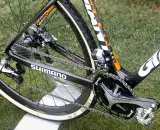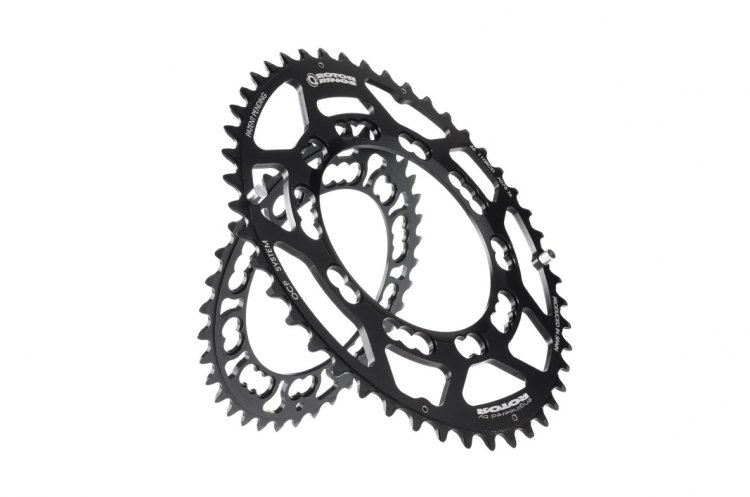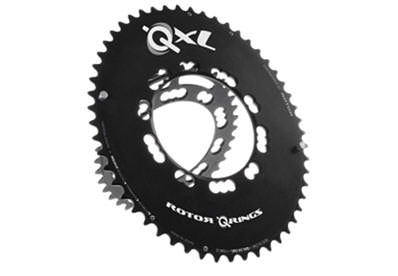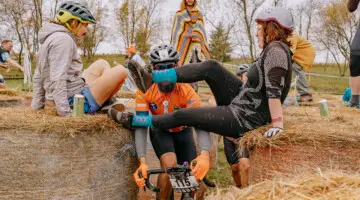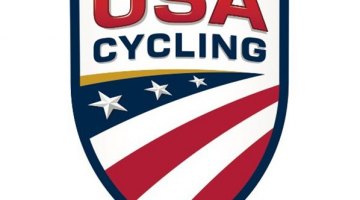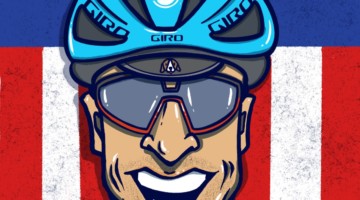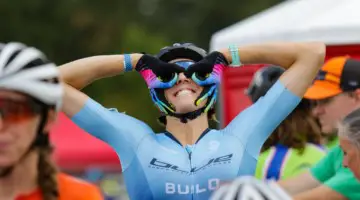Rotor is in the business of making chainrings for the riders who are interested in something just a bit different—though this isn’t just for the tech-nerds out there. Riders like Marianne Vos have been riding Rotor’s ovalized Q-Rings for years, and proving that maybe a circle isn’t the only way to a winning ride. Non-circular chainrings are nothing new (older rider may remember Shimano’s ill-fated Biopace from the ’80s, but Shimano took the opposite approach to Rotor), but they still aren’t well-known, especially to the “technically-disinclined” racers out there.
It’s been several years since we first looked at the Rotor Q-rings, and since then the company has launched cranksets, bottom brackets and QXL chainrings. We talked with Rotor last season to find out about their sponsorship of Vos, and get into the technical nitty-gritty of some of their pieces, including how the new QXL could be the ultimate single ring setup, now that single ring is officially back in style with the recently launched SRAM CX1.
Cyclocross Magazine: We have to start with your biggest rider: Marianne Vos sports Q-rings. She rides your rings, she’s done this for a long time. Is she a sponsored athlete?
Rotor: Yes, she is. It started off really grassroots. Marianne was a young girl, she was still a junior and one of our friends in the Netherlands, he knew Marianne. She was racing for Van Tuyl, which was a small custom bike manufacturer in the Netherlands, and we threw on the ’cross rings, and she won that race. And after that she just kept on winning and winning, and she said to us the one thing she loves most about them was that she would get ahead of other competitors at every technical section. So at the sand trap that people couldn’t get through she would plow her way through. The really steep crest of a dike that people would have to hop off on, she would ride over it and found that that technical advantage was what really set it apart.
[See Vos’ Worlds-winning bike here.]
CXM: How much research has been done on performance advantages for your rings? Especially in a ’cross environment?
R: We do have a study which is highly relevant to ’cross. It was done in a lab, it was done on trainers like all accurate scientific studies are. It was a 1 kilometer high-effort test. We found that on the trainers, when athletes riding at a high aerobic (not anaerobic) effort, they were saving 2.6 seconds per mile. And that is just the biomechanical performance advantage of the product. We don’t yet have quantified data (because we’re working on how to do it) as to what the technical advantages are of the better torque, which allows you to plow through the sand traps, which allows you to go over the crest of the dikes. That type of stuff is not really something you can quantify, but it is certainly something that all of the athletes who we sponsor praise about the product.
CXM: Could you just do the tests on trainer, but in a start-stop fashion that is more typical of cyclocross?
R: With the better torque curve, the acceleration is better with Q-rings, so that’s certainly something that would be indicative of how fast you get up to a certain speed level. It’s a good question—just a year and a half ago we brought on a new staff member, Christy O’Hara—she’s our sports scientist. She’s done a Q-rings study of performance benefits of a 1 kilometer high-effort situation. She’s now working on two more studies, and after that we’ll be putting on more and more. A peer-reviewed, statistically relevant, well-executed scientific study is something that takes a year to do, so they’re going to roll out slowly.
CXM: So Vos is amazing because she wins on the road, track, and now on mountain bikes. Do all her bikes have Rotor rings on them?
R: Every single one. The track bike had it for a while, but her track sponsorship changed. The chain-line growth is negligible on a Q-ring. On a 38-tooth ring, you’re looking at somewhere between 1/3 and 1/4 of a millimeter. So that’s less than the flex in the frame.
CXM: That makes sense because the chain wraps around half the chainring at any point. It will also work with singlespeeds?
R: It’s a design that was specifically made to be entirely stable. It’s meant to work perfectly with derailleurs. It’s meant to be something that’s not going to derail by itself. Johan Vansummeren [Ed. Note: who recently had a bad crash at Flanders, and we’re wishing him a speedy recovery] won Paris-Roubaix four years ago with it. You can ride singlespeeds, you can ride ’cross bikes, you can ride a track bike with a Q-ring without a chain tension system simply because its properly designed.
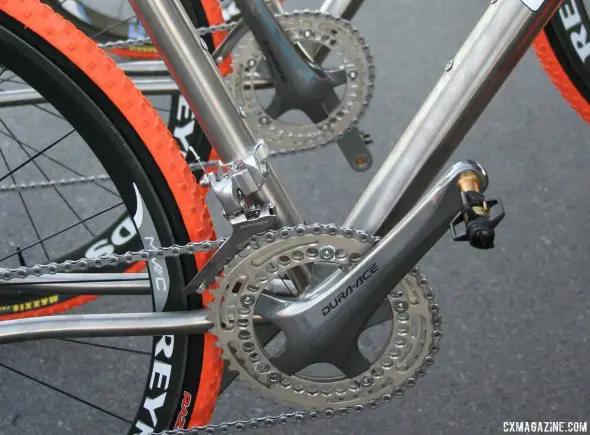
Rotor’s Q-Rings have been around for a while, shown here on the Litespeed Maxxis team bikes in 2009. © Cyclocross Magazine
CXM: So if you didn’t have to worry about reliability and chain tension, can you read between the lines and think that you would actually have more of an extreme shape like O-symmetric or something like that for maximum efficiency?
R: Yes, we’ve launched a product now which goes a little bit further—the QXL. The standard Q-ring we designed to be the perfect balance, which is a compromise. There’s always a compromise between biomechanics and stability. So 10%, we found, was the perfect compromise between shifting quality, stability to the drivetrain, and biomechanical advantage. That was something we found absolutely critical because you had this overbearing critical attitude towards oval rings. And if our rings simply didn’t work, it would get shut down. So no that we’re a few years down the road, and the credibility of the Q-ring is confirmed…. we’ve launched the QXL. The QXL will be awesome for cyclocross. Anybody who’s riding a 1×11 or 1×10, I would strongly advise them to go for the QXL 110 38t. It’s amazing. In England, we say it’s the mutt’s nuts. This thing is the dog’s bollocks. For any single setup, the QXL; for double setup, the standard Q-ring.
CXM: For single setup, whether it’s single ring, or singlespeed, with such a dramatic change compared to the Q-rings, do you have to worry about chainguards or tension?
R: I have a hardtail MTB with a QXL and I don’t have a tensioner and I’ve been riding it for a year and a quarter, and I’ve never lost my chain.
CXM: So why not move all Q-rings to the QXL?
R: Because the QXL is not a product that’s suitable for people who have not ridden a non-circular chainring before. The ovality is a little too extreme for people to be able to easily handle. So we recommend it being a second set upgrade. People who know they have a high percentage fast-twitch, who know that they have very fast engagement and disengagement dynamics, could go directly from a round ring to a QXL. The preconception of them (non-circular chainrings), is that they are unreliable and unstable. That’s what sets Rotor apart. We are a company that brings you the biomechanics, but we do not sacrifice in any way the critical stability or shifting performance.
CXM: One of your main competitors is Osymmetric. What would the main differences be between the QXL and Osymmetric?
R: We have a different biomechanical theory which is very apparent in the design of the rings. First of all, we want the drivetrain to work for the cyclists legs, within the bounds of stability and reliability. We also are aware that people’s pedaling strokes vary. One person achieves their maximum power early, and one achieves it later. That’s why we have adjustability. We want the entire drivetrain system to work for the legs, so the legs (as they are), can get maximum potential.
We respect Osymmetric and their product works; however, their idea is, in a way, might be that they see the drivetrain and the bicycle as separate detached elements. And their product is a drivetrain product which you need to learn how to use to achieve its effect. It’s also probably not suited to rough terrain. It might not be the best choice to make when stability is an issue.
CXM: You were saying single ring works great, you didn’t need a chainguard, could you actually run it singlespeed without a tensioner?
R: Yes, that’s how I’ve got mine set up effectively. That’s a 38 tooth QXL and 16-tooth rear and I’ve never lost my chain. The flex in the frame, the manufacturing tolerances of the axle spider, freewheel, chain cogs, already amounts to more than the chainline growth [due to the Rotor ring].
CXM: Last question, what’s the difference between the 3D, and the 3D+?
R: Both the 3D and 3D+ fall within our UBB concept that the crank fits your bike. The 3D has our UBB24 axle, and the 3D+ has our UBB30 axle. The whole concept is that the cranks fit every bike on the market and there are only two exceptions. For the 3D+, there’s a silly rhyme I came up with: It’s the 30 [mm] crank on the bike you own, unless you own a Trek Madone. So the 3D+ will fit any bicycle, with the exception of 24mm Trek pressfit frames. BSA, Italian, BB86, BB30, PF30, 386EVO, everything.
And the UBB24 does fit everything. That’s technically the difference- the 3D+ is a slightly lighter, slightly more balanced product. The 3D is the stiffest 24mm crank out there.
More info: rotorbikeusa.com
See Rotor’s video below further explaining their ovalized ring technology and philosophy:












